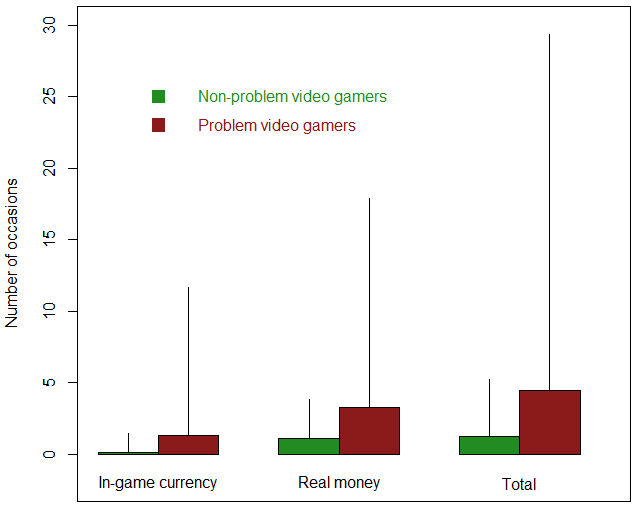From the design of games to the people who play them, there is important overlap between video gaming and gambling. At least as far back as the 80’s (e.g., Super Mario Bros. 2 in 1988), game designers have used gambling mechanics such as slot machines and card games, to give players extra resources and help them progress through the story. More recently, on streaming sites such as Twitch.tv, viewers are watching video game players dabble in online gambling, and online poker services and professional gamblers are broadcasting footage of poker tables and tournaments. This week, the WAGER reviews a study that explores whether video game players who have problems with their video gaming gamble more than those who do not have problems with their video gaming (Forrest et al., 2015).
Methods
- The researchers recruited 458 participants who self-identified as video gamers and had reported playing at least 7 hours of video games per week over the previous three months. They recruited participants using online advertisements on video game websites and flyers posted on the campuses of two South Australian universities.
- Participants completed a survey that included:
- The Game Addiction Scale (GAS) (Lemmens et al., 2009) to classify the participants as problem or non-problem video gamers.
- Example question: Did you have fights with others (e.g., family, friends) over your time spent on games?
- Self-reports of whether or how often they had gambled using (1) in-game or (2) real money during the previous three months using a five-point scale from never (converted to 0 times in the past 3 months) to “daily” (converted to 90 times in the past 3 months).
- For each participant, to obtain a total number of gambling occasions, the researchers added the number of in-game currency occasions to the number of real money occasions.
- The Game Addiction Scale (GAS) (Lemmens et al., 2009) to classify the participants as problem or non-problem video gamers.
- The researchers used independent sample t-tests to examine if the two groups of participants differed in the numbers of in-game gambling occasions, the numbers of real money gambling occasions, and the total gambling occasions.
Results
- Out of the 485 participants, 15.5% (n = 75) met GAS criteria for problem video game status.
- For the numbers of occasions gambling with in-game currency, real life currency, and both combined, the averages for the problem video gamers were not significantly different from the corresponding averages for the non-problem video gamers (Figure).

Figure. Mean numbers of occasions of gambling over the three month period, for non-problem and problem video gamers. The vertical line shows the sizes of the standard deviations. Click image to enlarge.
Limitations
- The study relied on self-reported categorizations of gambling involvement. The participants may have misrepresented their behavior, due to social desirability biases or poor recollections of the past. They may also have misremembered their gambling, or had different interpretations of the definition of an “occasion” of gambling.
- The researchers converted categorical variables into numerical variables. The numbers may not accurately reflect the amount of gambling done by the participants.
- The recruitment was limited to Australia. The results may not generalize to other video game player pools in other parts of the world.
- The researchers did not access whether participants also met criteria for gambling disorder; therefore, this study cannot determine whether the experience of gambling-related problems elevates risk for gaming-related problems, or vice versa.
Conclusion
In this study, Forrest and his colleagues did not observe any overall association between problem video game playing and frequency of gambling behavior. However, it is still possible that there might be associations within subgroups of video game players (e.g., competitive players versus noncompetitive players, specialists in one genre of games or another). Astute fans of certain card and puzzle games, for example, are likely better able to recognize situations where the effects of skill end and blind luck determines victory and defeat. Such people will probably be less likely to gravitate towards or have problems with games of pure chance such as slots, roulette, or bingo. Research into the overlap between the video game playing community and the gambling community is still in its early stages.
— Matthew Tom
What do you think? Please use the comment link below to provide feedback on this article.
References
Forrest, C. J., King, D. L., & Delfabbro, P. H. (2015). The Gambling Preferences and Behaviors of a Community Sample of Australian Regular Video Game Players. Journal of Gambling Studies.
Lemmens, J. S., Valkenburg, P. M., & Peter, J. (2009). Development and Validation of a Game Addiction Scale for Adolescents. Media Psychology, 12(1), 77–95.





Mark January 3, 2016
this is superb